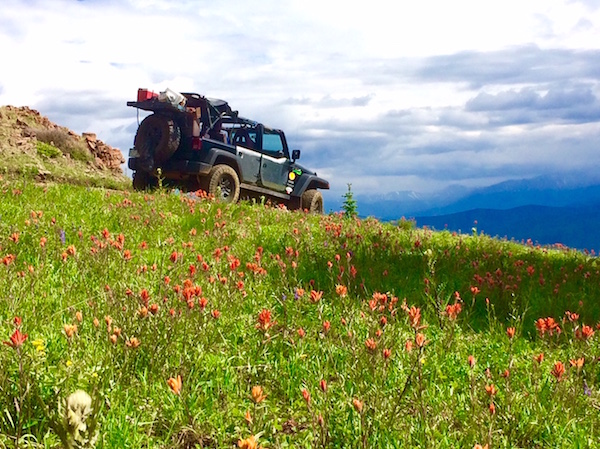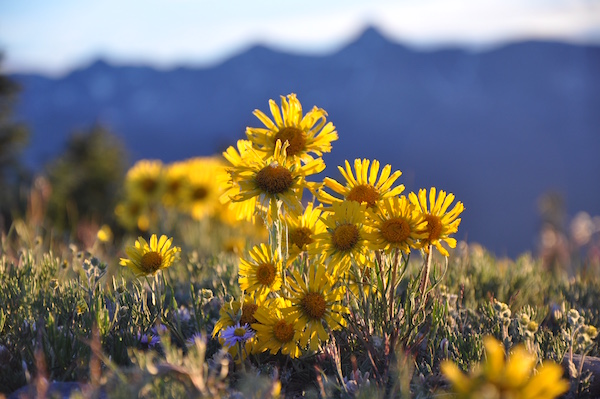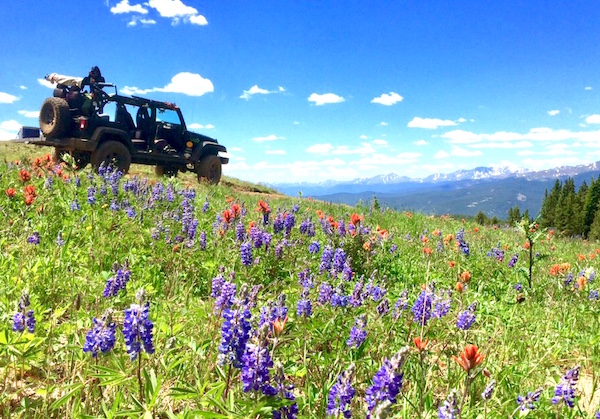July is high season for exploring Colorado wildflowers, and a Vail jeep tour is one of the best ways to do just that. Bright purple, yellow, and orange pops of color splash across high alpine meadows, making the mountains a lively place at this time of the year. And a Vail jeep tour will let you get up high and experience the beauty of the summer season in a way that’s simply not possible otherwise in half of a day. Plus, jeep tours are educational adventures, as guides share details about mountain flowers, wildlife, and local history along the way.
We hope you get outside to experience Vail’s natural beauty with us this summer. Until then, here’s a preview of a few common Colorado wildflowers that you’ll likely spot on a Vail jeep tour in the high country during the month of July:
INDIAN PAINTBRUSH

The Indian paintbrush is a bright, orange-blooming wildflower. One variety is a member of the genus name Castilleja, which is named after Spanish botanist Domingo Castillejo. The showy red-orange parts of this flower are technically bracts, a type of modified leaf, and not petals. Interesting fact about the Indian paintbrush: These plants are hemiparasites, meaning that although they are green and can photosynthesize, they also have the ability to sequester nutrients from other organisms, in this case, from perennial grasses. They do still rely on pollinators, and their red-orange color is especially attractive to hummingbirds.
Indian paintbrush also comes in other varieties and is called by other common names. In some areas, it can be yellow or more orange than red in color. One common name besides Indian paintbrush is prairie fire.
FLEABANE

The wildflower that goes by the common name of fleabane is also called feathered fleabane, feather-leaf fleabane, fleabane daisy, and mountain daisy. It can range in color from yellow to lavender (with a yellow center) to white. Fleabane is in the large genus Erigeron in the sunflower family. In the Rocky Mountains, fleabane grows at high altitudes ranging from 9,000 to 13,000 feet, so a jeep tour is a great way to gain the altitude quickly in order to explore the beauty of this flower in bloom.
COLUMBINE

Wildflowers that go by the common name “columbine” belong to the genus Aquilegia, and the columbine variety that’s white and lavender in color, Aquilegia caerules,
is Colorado’s state flower, also called the Rocky Mountain columbine. While this columbine variety is the one most often seen on Timberline’s Vail jeep tours, columbines also come in a variety of sizes, shapes, and colors including red columbines and yellow columbines. These differences have evolved over time in response to pollinators including hawk moths, hummingbirds, and bees.
According to Mountain Reservations, here are a few fun facts about Colorado’s state flower, the columbine:
*The columbine’s journey to become the Colorado state flower began in 1891 when Colorado school children voted the Rocky Mountain columbine their favorite flower.
Columbines are protected by law: A 1925 statute made it illegal to uproot columbines on public lands, and the gathering of blossoms and buds is limited to 25 in one day. Columbines may not be picked at all on private land without the consent of the landowner.
*The common name “columbine” comes from the Latin word for “dove,” due to the resemblance of the inverted flower to five doves clustered together.
*Native Americans are said to have used the columbine as a herbal remedy to treat ailments from fever to heart tension and even poison ivy pain with columbine-infused tea.
LUPINE

Lupines are bright purple bloomers that grow well in Colorado’s high country because they thrive in dry, sandy soil, and they’re repulsive to deer. They can also be quite toxic to humans, and the use of this plant for medicinal purposes is not recommended due to its toxicity and fatal potential. Lupines, also sometimes called sundials, have a unique leaf structure, so get up close to this wildflower and explore its pinwheel-like leaf structure as well as its purple blooms.
Interesting fact: Lupine gets its name from the Latin word lupus, meaning “wolf” and alluding to the belief that these plants robbed the soil, which is the opposite of the truth. Lupine actually helps to increase soil nitrogen.
If you’d love the chance to explore Colorado wildflowers while having an outdoor adventure, then a Timberline Tours Vail jeep tour will give you plenty of opportunities to enjoy both this summer, so give us a call to book your trip today!
The following websites aided in research for this post:
–Mountain Reservations
–USDA / US Forest Service

CONTACT TIMBERLINE TOURS TODAY
Timberline Tours is the Vail-area’s premier whitewater rafting and backcountry jeep tours outfitter, also offering stand up paddle board (SUP) and duckie river trips on Colorado’s Eagle, Colorado, and Arkansas Rivers. All of our guided trips are open to Vail, Colorado visitors, locals, families, and corporate groups.
To book your Vail, Colorado adventure, call Timberline Tours at (970) 476-1414, or email us at info@timberlinetours.com.
